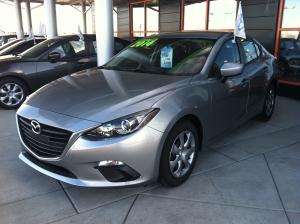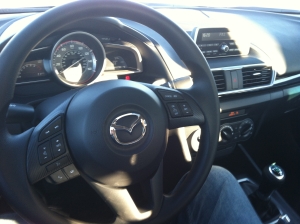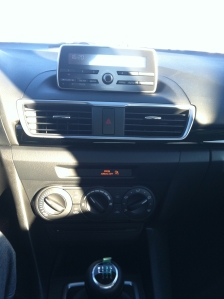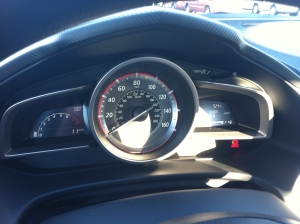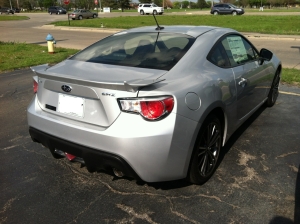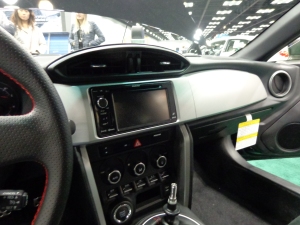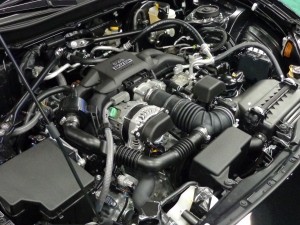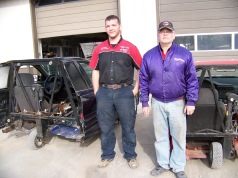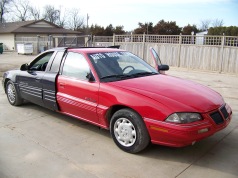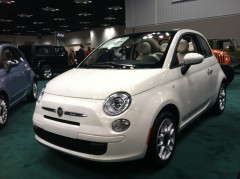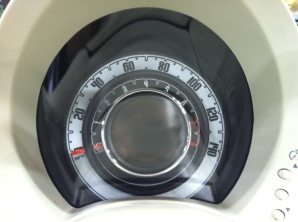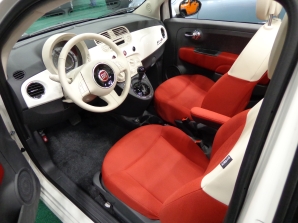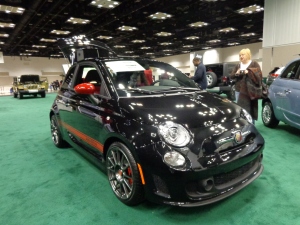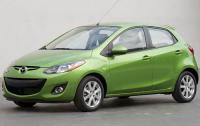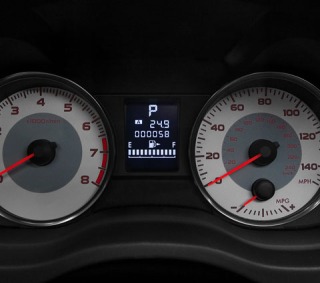Quick Test Drive: 2014 Mazda3
Posted by stocjoe in Uncategorized on January 22, 2014
Today’s small car segment is one of the most competitive segments in the industry. In this world of ever increasing demand for better fuel economy, manufacturers have been upping their game and introducing more models all the time. Subcompacts have been a big part of the boom, but the bread and butter small sedans and hatchbacks are still key players, and today, offerings from overseas and the US are competitive and appealing. So, keeping your car current and at the top of its game is imperative.
The Mazda3 was a car that, despite still garnering praise from the press, needed a redesign, and that’s what it got. The 2014 Mazda3 is a ground-up redesign that shares much of its technology with the CX-5 crossover and 6 midsize sedan. It continues the “Kodo” styling language introduced on the CX-5 and 6 with great success. The Mazda6 is still the most elegant application of the look with longer, more graceful curves, but the 3, particularly in hatchback form, is quite attractive and the smaller shape does give it a sportier appearance.
The Mazda3 starts at $16,945 for the i SV and the top end s Grand Touring starts at $25,995. The 3 is available with either a 2.0L or 2.5L engine, each with an impressive 13:1 compression ratio. The 2.0 produces 155 hp and 155 lb-ft of torque, while the 2.5 yields 184 hp and 185 lb-ft of torque.
Disappointingly, the only option for manual transmission users is the lower powered 2.0. Rumors on the web say that a manual should be available with the 2.5 sometime this year, and considering that the same 2.5 is available with a manual in the Mazda6, it would be quite surprising if it never became an option. But, as a result, the Mazda3 I had the privilege of sampling was a 2.0L model.
The car I drove was rather modestly equipped. It was a Mazda3 i Sport sedan with a cloth interior and steel wheels with covers. It was nearly the base model, but a lower end SV trim is available for less. If you really need to save money, an SV isn’t a bad option, as it still comes with niceties like air conditioning and USB connectivity, but cannot be equipped with cruise control, and oddly enough, doesn’t come with split folding rear seats. Standard features on the Sport included cruise control, air conditioning, USB and Bluetooth connectivity, steering wheel-mounted controls, tilt/telescoping steering wheel, power windows and locks, remote keyless entry, push-button start, and that’s about it. This model came without any extra options.
Inside, the Mazda3 is a fairly nice place to be. Everything is put together nicely, and the doors close with a soft and satisfying thud. The dashboard uses plenty of soft touch plastics, although harder varieties can still be found. What’s worth noting is how understated and simple the interior feels. Certainly there are interiors that are simpler, the current Impreza springs to mind, but in contrast to cars like the Focus, Civic, and Cruze, the 3 has a very basic, unpretentious interior. The controls were also quite intuitive and easy to use. The location of the stereo controls is also an interesting style point. The controls are set up in a little pod, like a small monolith, poking up out of the top of the dashboard. They are easy to read and access, and if your 3 comes with touch-screen audio and navigation, a screen takes its place, resembling an iPad. I’m not sure I’m completely taken by the design, but it’s certainly not unattractive. It will also be interesting to see how one might install an aftermarket stereo. The instrument cluster is also simple and easy to use. I’m not a big fan of the digital tach on the lower models, though. It works well for what it is, but I’d much rather have the center dial dedicated to revs instead of speed.
The interior is certainly on the dark side, with a charcoal cloth, black plastics, and thick pillars. However, the pleasantly short dash and a windshield that isn’t as steeply raked as many other cars, providing good forward visibility. The one other downside to the Mazda3 is interior space. The front has plenty of room and is easy to find a comfortable position. But the rear seats are a tad short on rear space. I can sit reasonably comfortably behind myself, but legroom is certainly not class-leading. Cargo space also isn’t class leading, but it is still competitive with most other small cars.
One area the Mazda3 has always excelled in is driving, and this generation isn’t any different. Professional reviewers have raved about this generation’s driving aptitude, and although my test drive involved city streets and highways, I have no reason to disagree. The whole car is very responsive. The shifter is positive, easy to use, and has fairly short throws. The steering, while featuring electric power assist, is linear, accurate, and feels good. It is on the light side, and a little more feel could be nice, but very good overall. The car handles with little body roll and turns eagerly.
The engine is also quite eager. I was a little concerned that the 2.0 would feel a bit sluggish, but I found it to be a willing companion in town and going up on-ramps. It’s also worth noting that while the 2.0 is down 29 hp and 35 lb-ft of torque compared with its larger displacement sibling, it also has much less weight to work with when equipped with a manual. A manual Mazda3 2.0 weighs in at 2781 lbs and the automatic Mazda3 2.5 (the only available combination) is 201 pounds heavier at 2982. It also gets one mpg better in the city, and two on the highway (29/41 vs. 28/39). How the two compare in real life I can’t say for sure though, as I only drove the 2.0 today. But, even with the 2.0, the Mazda3 was a very enjoyable little car to drive, and I imagine a manual equipped 2.5 could be even more fun.
As far as small cars go, the Mazda3 is an excellent choice. It’s a very sharp looking little sedan, or hatch if you prefer, that offers an attractive and comfortable interior, and great driving dynamics in an economical package. It’s a little short on space compared with the competition, but if style and fun for little money are your primary goals, you can’t go wrong with a 3.
I’m Seeing Double!
Posted by stocjoe in Uncategorized on March 26, 2013
Unusual automobiles show up in all sorts of shapes and sizes all over the place. However, it still comes as a surprise when an example of automotive uniqueness shows up in your own backyard. But sure enough, that’s what happened in this case.
 A couple weeks ago, a friend of mine posted a Craigslist ad for a “Pontiac Twin Car.” The preview picture was pretty surprising. The ad was for not one, and not two Pontiacs, but really two halfs of Pontiacs. On one end was the front end of a ’94 Pontiac Grand Am, and on the other end, the front end of a ’00 Pontiac Grand Am. It certainly caught my eye, and apparently the eyes of a few other places, even Jalopnik. Knowing that there was a vehicle this unusual just down the road from my dorm at McPherson College, I decided I had to see this car for myself, and meet the people behind its creation.
A couple weeks ago, a friend of mine posted a Craigslist ad for a “Pontiac Twin Car.” The preview picture was pretty surprising. The ad was for not one, and not two Pontiacs, but really two halfs of Pontiacs. On one end was the front end of a ’94 Pontiac Grand Am, and on the other end, the front end of a ’00 Pontiac Grand Am. It certainly caught my eye, and apparently the eyes of a few other places, even Jalopnik. Knowing that there was a vehicle this unusual just down the road from my dorm at McPherson College, I decided I had to see this car for myself, and meet the people behind its creation.
So, last Tuesday afternoon, after arranging a time to visit, I drove over to Auto House Collision Repair Center to see the push-me-pull-me Pontiac. I spoke mainly to Eric Unruh who listed the vehicle that he and his dad built. Eric has been working at the shop that his dad started for most of his life, and he and his dad have been working on all variety of vehicles. When Eric was a kid, he and his dad built go-karts, and even turned a John Deere pedal tractor into a powered, pulling tractor. Nowadays, beyond shop vehicles, they have a few racecars they build and take dirt-track racing at Salina Speedway. More specifically, Eric drives both Mod-Lite class cars (like smaller versions of Modified cars using motorcycle engines), and front-wheel-drive compact cars (Preludes, Neons, etc.).
It was the connection to Salina Speedway that started their foray into a push-me-pull-me type car. Eric and his father told me that a friend of theirs had the original idea. Their friend does clowning shows at the racetrack, and thought that such a car would be a great addition to the show. So he talked to the Unruhs, and the project began.
The resulting car is quite interesting. It was constructed from two Grand Ams that had suffered damage to the rear. The vehicles were cut apart, and work began to make them into a single unit with a twist: both parts of the vehicle can be separated and driven individually. The two halves were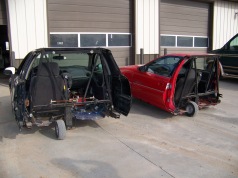 constructed with their own roll cages, separate fuel systems, and caster wheels mounted to electric jacks. On the 2000 Grand Am, a latching mechanism is attached to the hand brake lever. When stationary, the electric jacks can be lowered, and the latch released to let the two Pontiacs scamper off in their own directions. Eric and his dad estimated that it took only about two weeks worth of work to get the car into a fully functioning state. And the result is a very entertaining thing to watch, and according to Eric, just as entertaining to drive. (Video link in photo below)
constructed with their own roll cages, separate fuel systems, and caster wheels mounted to electric jacks. On the 2000 Grand Am, a latching mechanism is attached to the hand brake lever. When stationary, the electric jacks can be lowered, and the latch released to let the two Pontiacs scamper off in their own directions. Eric and his dad estimated that it took only about two weeks worth of work to get the car into a fully functioning state. And the result is a very entertaining thing to watch, and according to Eric, just as entertaining to drive. (Video link in photo below)
As a result of the extensive surgery, there are occasional handling quirks. As Eric informed me, losing half of the car makes it very light at the back, and that you want to be easy on the brakes as the back is much more likely to lift up. There also isn’t a way to lock the steering on one end of the car, so it’s best to have two people at the wheel when the halves are together. While this may seem like a minor inconvenience, it has its benefits in that you can drive the car sideways in a straight line, and can corner even tighter than a normal Grand Am!
 Of course you might be wondering, if this car was built for a specific buyer, why are Eric and his father selling it? Well, as it turns out, their friend decided that he wasn’t going to use it for one reason or another, and Eric and his dad couldn’t find any use for it, so it’s been listed on Craigslist. They are currently asking $2200 and I honestly don’t know where else you would find a car like this. And if it helps, the air conditioning still works on at least one of the halves, so if you need to drive your double-sided Pontiac in hot weather, you can still stay cool. As for whether or not there are any other unusual projects in the future, Eric wasn’t sure but he said, “If we find something cool, we’ll build it.” So, if you find yourself in central Kansas needing a push-me-pull-me Pontiac, or have some other automotive project needing work, you know where to go.
Of course you might be wondering, if this car was built for a specific buyer, why are Eric and his father selling it? Well, as it turns out, their friend decided that he wasn’t going to use it for one reason or another, and Eric and his dad couldn’t find any use for it, so it’s been listed on Craigslist. They are currently asking $2200 and I honestly don’t know where else you would find a car like this. And if it helps, the air conditioning still works on at least one of the halves, so if you need to drive your double-sided Pontiac in hot weather, you can still stay cool. As for whether or not there are any other unusual projects in the future, Eric wasn’t sure but he said, “If we find something cool, we’ll build it.” So, if you find yourself in central Kansas needing a push-me-pull-me Pontiac, or have some other automotive project needing work, you know where to go.
Tokyo Auto Salon 2013: Race Cars
Posted by stocjoe in Uncategorized on January 30, 2013
The big draw for me at the Tokyo Auto Salon was all the amazingly modified cars that are on display. But those aren’t the only vehicles that show up at show. As it turns out, to my surprise and delight, some pretty cool race cars from the past and present were on display this year. Two of Honda’s 1960’s Formula One cars were on display, one from 1967 at Honda’s booth, and one from 1964 at the NGK booth. What I love about these cars are the elaborate twisting headers sprouting from the rear mounted engine. And speaking of F1 there was also a 1996 Ferrari Formula One car on display.
Super GT cars were also out in force, ranging from Toyota Prius, to Honda CR-Z, to GT-R, and the lamented HSV-010. The HSV was what came of the remains of Honda’s canceled NSX project. The plan was originally to have a V10 mounted up front for the next generation NSX, but economic conditions led Honda to cancel the project. The Super GT HSV was developed from the stillborn NSX. As many of you know, the NSX will return, but instead with a mid-mounted V6 hybrid. I still look forward to the newest interpretation of the NSX, but I still wonder what a front engine V10 NSX would have been like.
Le Mans cars also showed up, and this probably excited me the most. Last year marked a serious return of Japanese cars to the big prototype leagues at Le Mans. Toyota fielded two LMP1 prototype cars, both gasoline hybrids, against Audi’s nearly invincible entries. Although they were not victorious, it was still a big deal to see them on track and being reasonably competitive. One of those Toyota racers was on display this year. Almost more exciting was seeing the DeltaWing (powered by Nissan) race car at the Nissan booth. The DeltaWing is one of the most radical race car designs to come up in many years. It’s design involves a very narrow track up front with a wide section at the back. The idea is that the car is half the weight and half the aerodynamic drag of its competitors, and as a result, only needs half the power and half the fuel of its competitors. It’s proven to hang well with the established racers, but how to classify it has been a major issue, with the car being relegated to experimental classes. The other issue has been completing a race without wrecking. Through no fault of its own, the DeltaWing has had unfortunate incidents where other cars have taken it out of contention. Ironically, at Le Mans 2012, it was taken out by a Toyota. The other Le Mans racer on display was Mazda’s new diesel powered LMP2 car. This car is brand new and marks Mazda’s return to Le Mans this year. Mazda is the only Japanese manufacturer to ever win Le Mans overall, and the only one to do so with a rotary engine. Since Le Mans is generally dominated overall by the LMP1 class, I doubt that we’ll see Mazda take an overall win, it will be interesting to see how it does in the LMP2 class.
And besides all of these, there were race cars of a slightly more stylized persuasion. Inside the show there were a handful of drift cars scattered about, but it was outside that you could see some D1 Grand Prix drifters putting their cars through their paces in a small course marked out in the exhibition area. Each driver had two solo runs, one a warm-up and the other a scored run, and then they ran tandem drift runs. Though I’m sure it wasn’t quite as spectacular as at a full scale race circuit, it was still brilliant to see some pretty impressive car control, and a healthy (unhealthy?) amount of smoke in such a small area.
Also, be sure to check out the videos linked to YouTube down below for a taste of the drifting action at Tokyo Auto Salon:

Tokyo Auto Salon 2013: Wow!
Posted by stocjoe in Uncategorized on January 29, 2013
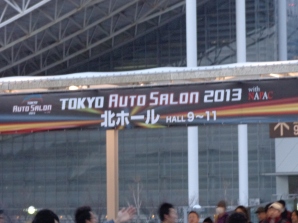 I love cars, and I love all types of cars, but I do have a personal fondness for imports, and especially modified imports. I have little doubt that growing up with the Fast and Furious movies and games like Need For Speed Underground, and Midnight Club 3: DUB Edition. I’ve had a lot of exposure to modified cars and especially modified imports. As such I’ve always followed coverage from car media outlets about these kinds of cars and some of the biggest shows featuring modified cars.
I love cars, and I love all types of cars, but I do have a personal fondness for imports, and especially modified imports. I have little doubt that growing up with the Fast and Furious movies and games like Need For Speed Underground, and Midnight Club 3: DUB Edition. I’ve had a lot of exposure to modified cars and especially modified imports. As such I’ve always followed coverage from car media outlets about these kinds of cars and some of the biggest shows featuring modified cars.
Two of the big shows that stood out to me over the years have been the SEMA Show in Las Vegas, and the Tokyo Auto Salon in Chiba. Of course both shows had some inherent obstacles for the average person to overcome to see either show in person. SEMA (Specialty Equipment Manufacturers Association) is closed to the public so only members of the industry and press can go to the show. Tokyo Auto Salon, although open to the public, has the issue of being very, very far away from central Indiana, so is expensive to go to. However, in a fortunate convergence of events over the past year, I was able to earn enough money, as well as be able to take time off from school in order to go to the Tokyo Auto Salon. And let me tell you, the trip was worth every penny.
The show is at the Makuhari Messe convention center in Chiba and lasts a weekend in January from Friday to Sunday. Friday is reserved for press and people who have purchased special preview tickets, and Saturday and Sunday are open to the public. So I set off Saturday morning for the first public day of the show. Fortunately that day, as well as the next, had quite nice weather. In fact it was right around 50 degrees fahrenheit so I was unencumbered with heavy jackets or coats. Immediately upon stepping off the train and into the main part of the station, I saw signs pointing toward Makuhari Messe. All things being said though, I think I probably could’ve followed the very large crowd to where it was headed and still made it just fine.
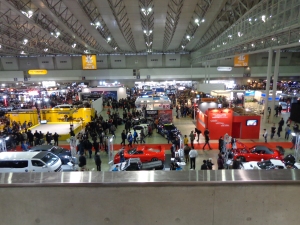 The main path from the station to the convention center was mostly on an elevated walkway and on the roads below you could see the occasional Japanese sports car: a Nissan Silvia, a Toyota GT86, a Subaru Impreza STi. And as you got closer to the convention center, you could start to hear the sounds of engines echoing behind the building from the demonstration area.
The main path from the station to the convention center was mostly on an elevated walkway and on the roads below you could see the occasional Japanese sports car: a Nissan Silvia, a Toyota GT86, a Subaru Impreza STi. And as you got closer to the convention center, you could start to hear the sounds of engines echoing behind the building from the demonstration area.
After a short walk through the somewhat drab hallways I entered the first exhibition hall. Before me lay an enormous room covered in cars. Once down the escalator, all that I could think was, where should I start, and where do I go next? So without any sort of plan, I just started off with whatever was right in front of me, and sort of snaked my way through the halls, booth by booth.
 And good grief was there a lot to see. At first, having not read the map, I thought that it was just going to be one major exhibition hall, maybe one other. However, it turned out that the first exhibition hall was just one of four, and that’s not counting the outside exhibition area. It was unbelievable, not just in size but in the fact that it was only a three day show. And the reality is, it would be absolutely crazy to try and cover everything I saw at Tokyo Auto Salon in one post. So over the next few days, I will be putting up posts that cover highlights and help show what this amazing event was like. So stay tuned!
And good grief was there a lot to see. At first, having not read the map, I thought that it was just going to be one major exhibition hall, maybe one other. However, it turned out that the first exhibition hall was just one of four, and that’s not counting the outside exhibition area. It was unbelievable, not just in size but in the fact that it was only a three day show. And the reality is, it would be absolutely crazy to try and cover everything I saw at Tokyo Auto Salon in one post. So over the next few days, I will be putting up posts that cover highlights and help show what this amazing event was like. So stay tuned!
Cars and Car People: Can’t We All Just Get Along?
Posted by stocjoe in argument, car people, carbureted, cars, diversity, domestics, forced induction, fuel injected, fun, get along, imports, modified, naturally aspirated, new, old, restored, unity, variety on June 24, 2012
The car world is one of wide variety and deep passion. It’s a fascinating world, and there’s always something going on somewhere, and it never seems to stop shifting and evolving. It’s one of the things that keeps me interested and curious about the various goings on in this world. The passion runs deep too, sometimes too deep I would venture to say. I’ve noticed that some people tend to get so entrenched in their respective vehicular niche that they are at least indifferent to other car groups, and actively criticize and hate other groups. This is something that needs to change.
 Before going any further, I want to say that having a favored niche is perfectly all right and in a number of ways is beneficial to the greater automotive community. Without people focusing on a certain style, region, make, or model of vehicle, we wouldn’t have the passionate and ever changing environment that is needed to keep the culture, the industry, and the excitement alive.
Before going any further, I want to say that having a favored niche is perfectly all right and in a number of ways is beneficial to the greater automotive community. Without people focusing on a certain style, region, make, or model of vehicle, we wouldn’t have the passionate and ever changing environment that is needed to keep the culture, the industry, and the excitement alive.
However, there is clear distinction between healthy enthusiasm, and harmful closed-mindedness. The latter is something I see far too much of. I find many people of every automotive background–muscle cars, tuner cars, factory correct vintage cars, and far more–and in every group there are people that can’t seem to accept other styles and cultures as legitimate in their existence. I find restoration guys that cringe at anything modified. I find muscle guys that hate anything foreign or low displacement. I find tuner guys that think domestics can’t do anything other than go in a straight line. It comes from all sides and while a little gentle joking is fine, it all too often is a result of genuine hate for that group’s favorite car or style.
This really is a shame. The automotive is too big, too varied, too exciting to restrict oneself to one area of the automobile. I personally have a fondness for tuner cars and imports, but that doesn’t mean that’s the only thing I’m interested in. I love seeing exotics, pre-war cars, muscle cars, heck I even get a kick out of bad cars like Yugos. It’s all great to see. I feel that people that can’t appreciate other types of cars are missing out on so much!
And for the skeptics, appreciate doesn’t mean that you like it. There’s a reason that there are so many kinds of cars out there. It’s because there are so many different people with different tastes, but none is less legitimate than the other, or done with less passion and love.
To appreciate the work, the passion, and the strengths of different people and automobiles is something that is so important to enjoying cars to their fullest. It’s also important in building the enthusiast community. If we can learn to appreciate and accept the diversity the automotive world has, the stronger we will be. It will be more welcoming for the new people, friendlier and more accepting of those already in it, and more enjoyable for everyone.
There are simply too many reasons why learning to enjoy a wider array of cars not do so. For the sake of ourselves and the hobby we all love, let’s put aside our prejudices and embrace the diversity the car world has to offer.
This lack of respect isn’t really that of individual to individual, it’s a lack of respect to all the niche groups and variations on the car hobby that exist in this world. People on the outside might not realize this, but “car guy” is a really broad term. When you break down the automotive world, you discover that there are probably hundreds, maybe thousands, of different car cultures all within the vehicular globe. You have people that are interested in specific makes, models, styles, regions, the list goes on.
 These groups are often fairly tight-knit, even when they span across the country through online forums. They usually take time to help each other in fixing problems, finding parts, and just spending time with each other or participating in car related events. But these specific groups rarely spend much time with each other, and can sometimes borderline hate people of different car scenes.
These groups are often fairly tight-knit, even when they span across the country through online forums. They usually take time to help each other in fixing problems, finding parts, and just spending time with each other or participating in car related events. But these specific groups rarely spend much time with each other, and can sometimes borderline hate people of different car scenes.
It is at this point that I should say that everyone naturally has their own likes and dislikes of different scenes, and the occasional, playful bantering between traditionally opposite ideas on cars. I will readily admit that my personal preferences have always been toward Japanese imports, often modified, and an example of something that I’m not crazy about would be donks. I and some of my friends also have some playful banter back and forth about our preferred cars. This is all fine, and can even be fun when not taken too far. But what I’m talking about is the stereotyping, ignorance, and disrespect shown to car culture that people don’t care for.
Being a modified import guy on a campus that consists of primarily domestic people and beyond factory perfect vintage automobiles puts me in a very small minority. And I have heard no shortage of disrespectful things said about Japanese cars and modified cars. Broadening the genre a little further, and modified cars get plenty of disrespect as well. It’s understandable that a place that is focused on restoration will not be terribly excited about modifying cars, but modification shouldn’t be viewed as evil or disrespectful to automobiles and automobile culture.
Some people might say, “Well, if you don’t like the stuff that is focused on and is the majority, you should go somewhere else.” I’ve actually heard something similar to this before. But here’s the thing, I have nothing against proper restoration, old cars, or domestic cars. I like them too! Why can’t there be at least some acknowledgement that modified, Japanese, and other auto cultures are legitimate and interesting too?
 I also don’t want anyone to take this as targeting the vintage restoration crowd. I know plenty of people from my preferred car fanbases that also don’t have a lot of respect for others. I know that it’s a long running rivalry between import and domestic people that rarely sees any mixing or respect. And that’s silly too. Cars of all regions, eras, and levels of modification are all great and they all deserve recognition. No group is any better or worse than another.
I also don’t want anyone to take this as targeting the vintage restoration crowd. I know plenty of people from my preferred car fanbases that also don’t have a lot of respect for others. I know that it’s a long running rivalry between import and domestic people that rarely sees any mixing or respect. And that’s silly too. Cars of all regions, eras, and levels of modification are all great and they all deserve recognition. No group is any better or worse than another.
I want to see a world where you can have a pristine Bugatti Type 57 parked next to a twin-turbo 20b RX-7, a rat rod with a Cummins diesel, a 70s Monte Carlo jacked up on 30″ wheels, a new Lamborghini Aventador, a murdered out Escalade, a bosozoku Corolla TE72, and many, many, many more. And then, all the owners of all of those cars would be interested in everything that showed up.
 You see, the car world is too big, too varied, and too exciting to limit oneself to one area of cardom. By no means should one avoid specializing, if it weren’t for specialists we wouldn’t have such fascinating cars. But get out there and see what else there is. Lowriders, tuner cars, muscle cars, hot rods, rat rods, trail trucks, and more all are brilliant and all are done with the same passion for the automobile that everyone has. Even if you don’t like something, take the time to at least appreciate the unique piece that that person created and loves as much as the things you like.
You see, the car world is too big, too varied, and too exciting to limit oneself to one area of cardom. By no means should one avoid specializing, if it weren’t for specialists we wouldn’t have such fascinating cars. But get out there and see what else there is. Lowriders, tuner cars, muscle cars, hot rods, rat rods, trail trucks, and more all are brilliant and all are done with the same passion for the automobile that everyone has. Even if you don’t like something, take the time to at least appreciate the unique piece that that person created and loves as much as the things you like.
